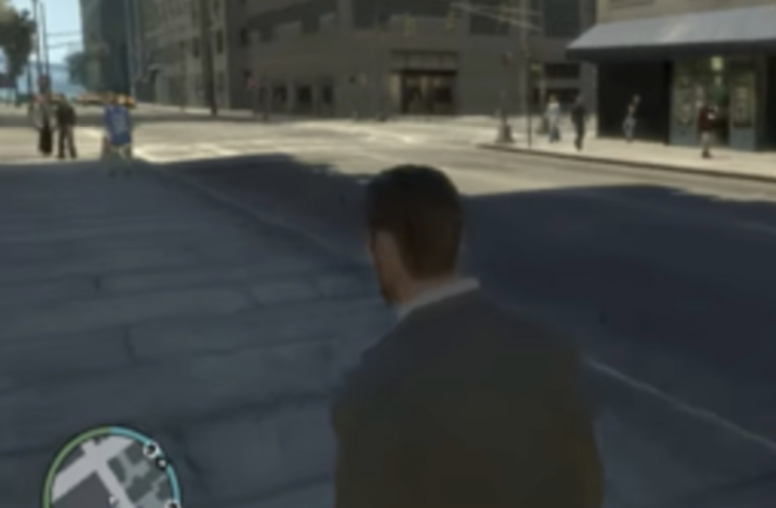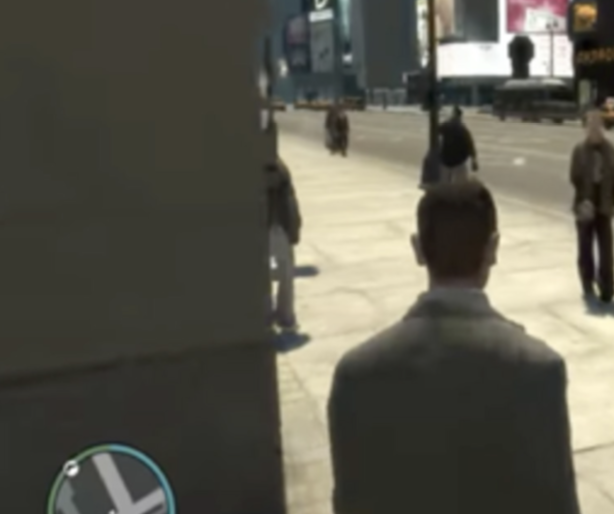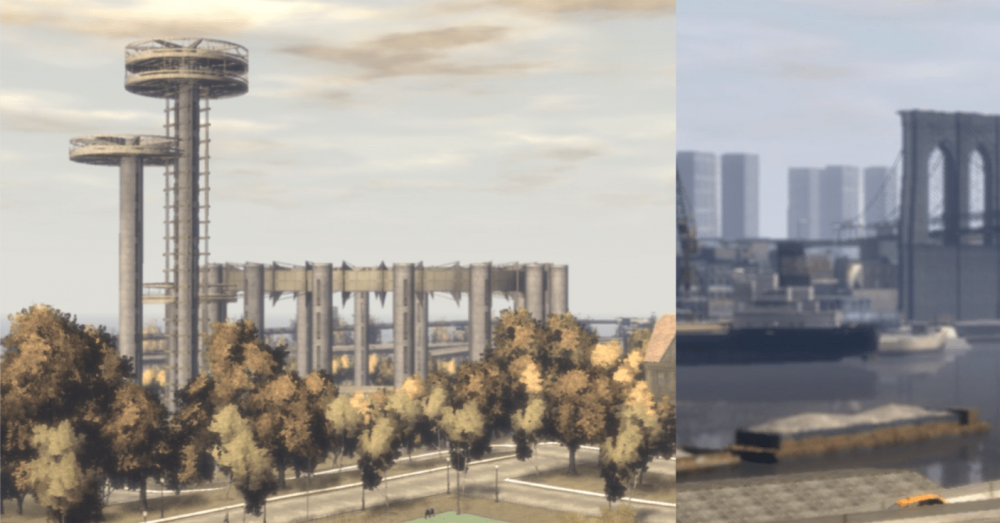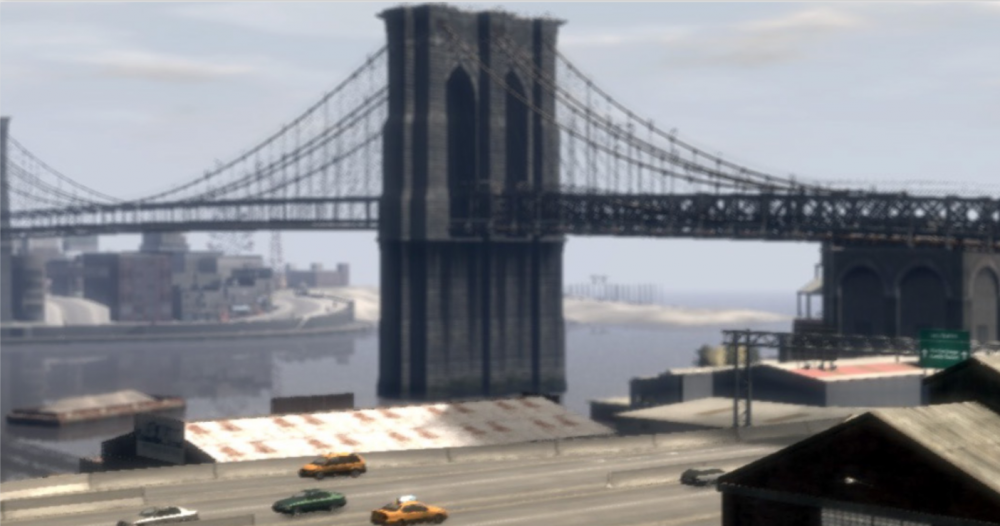The City Designed for Crime: An Analysis of Gameplay in Grand Theft Auto IV
Cindy Hernandez
Depictions of New York City in media often capture the nature of a city transformed by immigration, and with it comes a particular fascination with crime. In examining the unique populations that have developed within the city’s five boroughs, the task of representing New York’s geographic and cultural footprint becomes daunting for designers who create video games with open worlds. Such virtual environments, which allow players to roam and interact with its landscape and products in various ways, have created a scenario for real-life places to be “played” from a distance. Liberty City, in particular, is a parody of New York City found in various titles of the Grand Theft Auto video game series by Rockstar Games. One feels that it is New York not only by its monuments and geography, but also in the ways you get from point A to B—familiar forms of transportation found in yellow cabs, delayed subway trains, and by brushing against large crowds. Rather than focus on the similarities between the real Manhattan and the fictionalized Liberty City, this paper will highlight how certain aspects of Manhattan’s urban grid are incorporated into the version of Liberty City that appears in Grand Theft Auto IV (GTA IV) as a tactic for the person playing the game to move about space in the game with ease, thus allowing them to achieve more in the game than possible in real life.
Gameplay analysis will be based on the design concepts of the Player, the Objective, and Conflict in video games, as defined by video game designer and human-computer interaction specialist Lennart Nacke.1
The Player
Nacke defines the Player as an active member of their game system who voluntarily interacts with the video game.2 GTA IV ’s story mode format is Player versus Game, meaning only a single player interacts with the story at a given time. The Player assumes the role of the character Niko Bellic, a recent East European immigrant presumed to know nothing of New York. Because of this, there are times the Player is instructed by other characters to meet someone “new” to the story at a place not otherwise visited. The Player is challenged throughout the story to navigate new urban spaces that can present hurdles, both in the fun of gameplay, and as part of an immigrant narrative in a place totally foreign from their own experience. Donald Appleyard, in his study of the streets of San Francisco, suggests that individuals adapt to their built environments through the experience of interacting and maneuvering within them, an experience GTA IV magnifies.3
The Player (as Niko Bellic) is shown throughout the game from a third-person interactive perspective (meaning through the predictive technology of the interactive camera), which helps the Player anticipate certain movements, or manually via the console’s controller when the Player chooses. For example, when the character is walking around Star Junction (the fictional Times Square), the camera moves immediately towards a perspective where one anticipates what’s next. (Fig. 1, Fig. 2) In Figure 2, one can see a façade similar to Nasdaq MarketSite around the corner, visible because the character is walking toward a populated avenue. Something I found particularly interesting was how little I, as the Player, lifted my “head” in order to look at the buildings above. It wasn’t that the game didn’t recreate skyscrapers or landmarks particularly well, but rather that my main objectives were always on the ground. In comparison to Grand Theft Auto: San Andreas, which rewards the Player with the ability to fly around the fictional Los Angeles in a helicopter, almost all of my missions in the game emphasized this horizontal view. This is often similar to my experience of walking in Manhattan, which means I almost never look up from the base of buildings and only look for them as landmarks on the horizon for my own sense of direction. Because of the complexity of its landscape, the game’s design encourages the Player to rapidly change direction on screen, due to the various points of interaction which allow the character to enter buildings and interact with non-playable characters.

Figure 1. Screenshot of urban scene, taken by Cindy Hernandez from the video game Grand Theft Auto IV. Rockstar Games, 2008. Courtesy of Cindy Hernandez and Rockstar Games.

Figure 2. Screenshot of character turning corner, taken by Cindy Hernandez from the video game Grand Theft Auto IV. Rockstar Games, 2008. Courtesy of Cindy Hernandez and Rockstar Games.
The Commissioners’ Plan of 1811, which laid down the grid system that created the streets and avenues of Manhattan from 155th Street to Houston Street, featured notes from William Bridges describing the need for structuring the metropolitan area in response to population increase, noting, “The city of New York contains a population already sufficient to place it in the rank of cities of the second order and is rapidly advancing towards a level with the first.”4 To allow for this expansion in population, the streets—particularly avenues—were designed to be extremely wide, measuring 100 feet across, to account for the increasing population to come. Thus, the avenues of Manhattan today are almost always densely populated by both pedestrians and vehicles.
The game design of GTA IVencourages the Player to walk on avenues. One can look at a map of the “Midtown” area of the game and understand that specific points of interest for the Player are often located in the intersections of streets and avenues. (Fig. 3) This aspect of the Player interacting primarily with the avenue—which features centers of commercial and social activity—as opposed to a purely residential street, is a testament to the choice of modeling Liberty City on the idea of New York City. These heavily populated urban areas become the main sites of gameplay because the population of non-playable characters and vehicles in this shared space allows for significant challenges to be set up for the Player. In short, it’s as if you were walking to your crowded train station: everyone is in your way, and it’s a problem.

Figure 3. Screenshot of GTA IV map taken by Cindy Hernandez from the video game Grand Theft Auto IV. Rockstar Games, 2008. Courtesy of Cindy Hernandez and Rockstar Games.
Jane Jacobs argues in The Death and Life of Great American Cities for the use and implementation of short blocks, as opposed to long rectangular blocks, citing the area of Greenwich Village as the perfect example of an urban environment.5 In particular, she argues that when one lives on the long rectangular streets of Manhattan, it is increasingly more difficult to walk from the street over to the avenue, making the individual a member of the commercial avenue running throughout the city and losing a sense of care for the urban space they reside in.6 Michel de Certeau suggests that this grid-like map, which the urban dweller (much like the Player) is taught to follow, does not reflect the ways in whichurban space is ultimately manipulated and used by the individual, who by walking in the city already omits the objective nature of the map and prefers to carve out an experiential “tour” of space.7 These places in the game become sites of various activities in GTA IV, most notably shaped by conflict and crime.
The Player is able to navigate the streets of Liberty City (and mostly does so freely toward the end of the game) by walking and driving vehicles such as sports cars and motorcycles. When the Player drives a vehicle, one will notice that most of the major avenues in Liberty City run in one direction only for vehicles, and the Player will run alongside the flow of traffic. Figure 4 shows the Player’s view on Star Junction as a driver, with yellow cabs all running south, exactly as they would run on the street in real life. (Fig. 4) However, unlike the monotonous traffic of a Midtown afternoon, the cars pass at an extremely quick pace and so does the Player while driving. The experience of driving in GTA IV is not from a realistic standpoint for the Player, who can drive between lanes on the Broker-Dukes Expressway (Brooklyn-Queens Expressway).(Fig. 5) Due to the sheer velocity of the car, as well as the huge amount of space between lanes (effectively making a “third lane” between an average two-lane street), the Player never needs to pay attention to traffic rules, even though there are repercussions for it such as being chased by police cars. This helps create a particular visual aesthetic to the effect of the world “blurring” around the Player, making one focus primarily on the road itself, rather than the skyline. This is just one highlight of the selfish game design of Liberty City. According to game scholar and designer Bobby Schweizer, the maps in various GTA games are designed to communicate that the Player is a public threat to the citizens of the game’s fictional city at all times.8

Figure 4. Screenshot of character in middle of traffic, taken by Cindy Hernandez from the videogame Grand Theft Auto IV. Rockstar Games, 2008. Courtesy of Cindy Hernandez and Rockstar Games.

Figure 5. Screenshot of player driving, taken Cindy Hernandez from the video game Grand Theft Auto IV. Rockstar Games, 2008. Courtesy of Cindy Hernandez and Rockstar Games.
GTA IV’s facilitation with crime is the main design contribution, and the propensity for crime to occur at any moment is demonstrated in certain aspects of gameplay. The Player’s main enemy is the city itself, and the use of cars in the game serves primarily as a mode of protection or evasion from the urban environment, rather than pure transportation. This is mirrored by Jacobs’ assertion that people living in dangerous cities often use automobiles as shields of protection, an idea which is subverted when the Player—while using their car for safety—is also a threat to the safety of all the non-playing characters in the game, who are designed to both drive cars and walk the streets of Liberty City “properly,” and thus are constantly susceptible to tragic accidents. It’s interesting to experience the feeling that the game is designed to make non-playable characters extremely aware of the presence of the Player on the grid, with cars moving out of the way at times if you bump into them. Overall, Grand Theft Auto IV’s understanding of the Player, outside of the story mode as Niko Bellic, is that of a character fighting for permission and dominance of urban space at all times. This theme is further explored when considering the Objective and Conflict of the game itself.
The Objective
A mission in GTA IV immediately introduces the Player to a new space previously unavailable to “tour,” as de Certeau would put it, by unlocking it as interactive content within the game. In order to reach the Objective of the mission, the Player must be taken to a space they do not immediately recognize. A comparable example would be like walking out of an unfamiliar subway stop in order to reach your “Objective,” or destination, above ground—having to figure out which exit from the station gets you closest to where you want to be. At the game’s beginning, the entire “city” is not open to the Player or Niko Bellic; the Player begins the game unable to drive, walk, or take the train to places outside Bellic’s first apartment in Hove Beach (Brighton Beach). To advance missions, and thus unlock the entirety of Liberty City as a vast open world to explore, Niko Bellic relies on knowledge from his cousin to understand what lies beyond South Broker (South Brooklyn). The anxiety of the mission pushing the Player toward extremely developed urban areas is evident in the looming skyline of Liberty City’s Algonquin (Manhattan), serving as both backdrop to and metaphor of social and financial improvement for immigrants.9 Studying the image of the Manhattan skyline, Kevin Lynch describes the conglomeration of skyscrapers standing in for various meanings, but particularly power, congestion, and greatness.10 With New York City’s abundance of landmarks spanning vertically and horizontally, it makes sense for missions to revolve around the exploration (and maladaptive exploitation) of landmarks.
In the mission “Logging On,” the Player is introduced to the neighborhood of Outlook Park (a rendition of Prospect Park in the Park Slope neighborhood of Brooklyn) by the monumental entrance at Grand Army Plaza.11 (Fig. 6) The arch is used as a way to orient the Player between the main streets and avenues of Outlook Park. Instead of standing next to, observing, or driving by the arch, one could climb it or crash a car into it. Jacobs’ believes Prospect Park is all too susceptible to crime because of planned pedestrian street schemes—such as the traffic circle around Grand Army Plaza’s arch—which greatly disturb the natural order of the grid and seem to inspire problematic behavior in people.12 As such, in GTA IV, the Player is able to drive the car into Outlook Park, crash cars into the arch, and murder innocent bystanders on the way to their final destination for the mission, which is to log into an internet café and have the crime rewarded by unlockable trophies, cars, etc.

Figure 6. Screenshot of Outlook Park from the video game Grand Theft Auto IV. Rockstar Games, 2008. Source: https://gta.fandom.com/wiki/Outlook.
To perform crime in GTA IV, a chance for the misuse of urban space must always be available. The Objective in Liberty City is to get to where you want to be and fast—but as any New Yorker knows, obstacles along the way, be them architectural or social, stand in-between the ordered harmony of living on an urban grid. Completing the Objective, in real life as in GTA IV, can at times be difficult.
The Conflict
Nacke suggests that there are three main types of Conflict in video games: obstacles, opponents, and dilemmas. As an open world that requires the interaction of both the human and non-human object, GTA IV exemplifies all three of these possible Conflicts within video games. The Conflict of GTA IV is expressed as such: border divisions of boroughs as a physical obstacle, pedestrians as opponents, and adaptation/maladaptation to the urban grid as the dilemma.
Border divisions within New York City aren’t as obvious, architecturally speaking, as a giant wall or a grand entrance. Particularly in Manhattan, separation is structured through various cues that make the city seem disconnected from the rest of the surrounding urban fabric (New Jersey/Upstate New York). For example, the fact that Manhattan appears to be an island but is actually a peninsula accessed by multiple entrances via bridges, ferries, and tunnels strengthens its associations as a destination that suggests that this is the center of it all. The sheer density of its architectural and structural motifs make it thrive. GTA IV takes advantage of these “borders” to inform the necessity for crime that Niko Bellic feels forced to be a part of, both as an immigrant and as someone attempting to climb up the social ladder. The neighborhoods and landmarks in Liberty City rely on particular ethnic stereotypes based off the real population, making the borders ones of extreme parody that can be seen as being complicit with discriminatory and exclusionary ideas about immigrants and people of color.13 (Fig. 7)

Figure 7. Screenshot of Liberty States Pavilion Towers in Meadows Park from the video game Grand Theft Auto IV. Rockstar Games, 2008. Source: https://gta.fandom.com/wiki/Liberty_State_Pavilion_Towers.
The characters within GTA IV also physically live within parodies of their own identities. Because Niko begins his journey in Broker (Brooklyn), there is already an “old world” mentality to its characterization within Liberty City. The separation of the boroughs in Liberty City is very distinct, leading to a story mode that is rich with class anxieties regarding where one lives in Liberty City. The border between Algonquin (Manhattan) and Broker (Brooklyn) in the game is designed to heighten social intensity by emphasizing the water and skyscrapers separating the two boroughs, or what Jacobs’ called a medieval planning format,14 especially with the presence of the Broker Bridge (Brooklyn Bridge). (Fig. 8) The process of moving up in class in GTA IV’s narrative is essentially a domination of Algonquin, Liberty City’s physical and economic center. This anxiety is so prominent that earlier in the game, bridges are cut off to Algonquin due to the threat of “terrorism” disguised as “maintenance work.” The entrance to Algonquin only opens up when the Player rises in economic class and gathers more worthwhile material objects (nicer cars, better clothes, and so on). The only way to advance in the game, however, is to work within the physical borders pushed upon the Player by game designers, to exploit the borough of Broker and Dukes (Queens), before dominating Algonquin. When the Player behaves “correctly” within these physical borders, moving the storyline forward in ways that benefit the progression of plot (but not necessarily beneficial to the Player’s enjoyment of the game as a whole) through the completion of specific, crime-based missions, the Player is rewarded with spatial degrees of freedom. GTA IV’s gaming experience—or what the Player is in direct conflict with the most—is the limitation of moving within the urban space.15 GTA IV pushes the obstacle of navigating the unfamiliar city (despite its relative closeness) through a map, which helps the Player choose their battle between “the cartographic and material space.”16

Figure 8. Screenshot of Broker Bridge from the video game Grand Theft Auto IV. Rockstar Games, 2008. Source: https://www. grandtheftwiki.com/Broker_Bridge.
However, speaking from the experience of playing the game, the presence of the map acts more as a tease than as a helpful guide. The underlying anxiety of class division effected when playing GTA IV seems to be the driving factor in suggesting that any kind of crime is an appropriate reaction to the sequestering of space toward the Player. GTA IV asks us: How far would you go, and where?
As it turns out, you can go incredibly far. The game is filled with pedestrians (opponents) at all hours. In a city like New York where walkability is simplified due to the grid system, it makes sense that people would be out at non-normative hours, taking advantage of businesses and business owners who operate on different schedules. A problem one will run into when discussing the similarities of acting in an urban space to a video game replicating it is that ultimately, the non-playing characters are not capable of much. Instead of acting within the urban environment, for recreation or surveillance for example, the pedestrians are always in a hurry and walking or driving somewhere. Following pedestrians achieves nothing in the game because they’re not programmed to be individuals with specific goals, but only to appear as such. Each street in the game—regardless of whether you’re in Liberty City’s version of Times Square or the quieter South Bohan (South Bronx)—is considered what Donald Appleyard would call a “heavy” street, or a street with more traffic that has high rates of crime, noise, and pollution making friendliness, convenience, and appearance go down in its list of qualities.17 Non-playable characters are truly only opponents in that they’re physically in your way of getting anywhere. Despite the game rewarding the Player for crime in general, specific crimes are frowned upon if done in a way that’s visible to the public. GTA IV has a ranking mechanism that awards stars for performance—one star being sloppy to three stars being extremely successful. Committing violent crimes is rewarded so long as the obstacle of being seen is removed. This is circumvented by the Player in numerous ways such as getting into a new getaway car as opposed to the one they entered before, or changing their clothes to more expensive ones so that when the police arrive, they’ll assume the Player’s character was a wealthier man defending himself. Overall, the game deems non-playable characters who aren’t part of the plot as nuisances. There is no time for the Player to be part of the community of Liberty City or the community of the Player’s starting neighborhood. GTA IV also limits the kinds of interactions the Player has with others. They are either neutral/barely positive (such as exchanging money for goods and services) or they are extremely negative (any number of crimes) but the sheer amount of people randomly generated by the game leaves the Player with infinite possibilities to make anyone an opponent. Of course, your inability to truly get close to anyone is not just a game mechanic, it’s part of the plot; for a world that has shown little care for an immigrant veteran like Niko Bellic, the chance for morality to arise via interpersonal experiences is very limited.
The dilemma, finally, is the marriage of the opponent and obstacle. The Player is faced with the dilemma of whether or not to treat the actual game as a narrative of a space they recognize (given the ubiquity of New York City) or to treat it as an exploration of a new “place” that can be visited. Despite the highly detailed and observable parody of GTA IV, it is still not “real,” but because of this, the Player will engage with this digital fabrication differently. The salience of in-game tools to ease gameplay, such as on-screen text or maps in the corner of the screen, destroy the illusion of the game as tied to reality but firmly places it in the realm of play, which has physical and material actions such as the use of a controller.18 One argument could be made that the dilemma of GTA IV, which is to make choices that either appeal or don’t to the gamer’s mindset within a fictional New York, should only be looked at within the parameters of Liberty City and not Liberty City as an extension, response, or reflection of New York City itself. In fact, Liberty City is a highly visited (digital) place—an actual destination of tourism and recreation, as seen in the amount of people who play the game online, even ten years after its debut.19 Ultimately, it is difficult to speak about how the game is designed to integrate answering the dilemma via gameplay because of the sheer fact that Liberty City exists within the confines of a real place on a game platform. On the contrary, I think the best answer to understanding how GTA IV’s dilemma is the choice between adaptive or maladaptive behavior is to look at what kind of missions GTA IV uses in each borough. Despite the stereotype for crime, missions taking place in South Bohan (South Bronx) are usually petty crimes like stealing money or selling drugs. The same can be said of Broker (Brooklyn) and Dukes (Queens), where missions involve escorting mob daughters and rescuing people from kidnappers. In Algonquin (Manhattan) however, almost all the missions involve the Player committing mass murder. In other words, GTA IV trains the Player to look at Algonquin as a place where one must commit massive crimes to not only survive, but to expand their understanding of the digital space. Following the plot of the game by completing its missions is the only way the Player is able to unlock new ways to perform around the urban grid. These unlockable actions range in intensity of deviation and confrontation to crime. Thus, GTA IV’s dilemma is no real dilemma at all. It is the only option that is dynamic and indicative of action, as opposed to being a silent bystander in a city of millions.
Conclusion
Grand Theft Auto IV’s use of New York City as inspiration is both cultural and structural. The major emotional depth of the experience of playing the game is not found exploring the urban landscape, but rather in experiencing how the urban landscape unfolds through a narrative that sympathizes with the Player’s identity as an immigrant to a foreign, talked-about land of promise. After playing the game, understanding the separation within New York City has spurred questions about identity via its boroughs and neighborhoods. For example, do all New Yorkers feel attachment to Flushing Meadows Park if they haven’t lived in Queens? Do some New Yorkers feel ambivalence towards certain “icons” like Prospect Park because of inaccessibility? What living and playing in Liberty City has taught me is that, ultimately, the densely populated and ornamented city of New York contains multiple understandings of urban space that would be explored differently if depicted in a game that was strictly about a simulation of being alive, like The Sims. To play GTA IV as a New Yorker is a profoundly unique experience, as everything is uncanny. To see various landmarks and neighborhoods I’ve visited or grown up with, all represented as hokey in their parody, is unsettling in their dual existence, both on-screen and in real life. GTA IV makes a fantasy out of dominating a city that seeks to dominate you through its grandiosity in its physicality.20
1 Lennart Nacke, “The Formal Systems of Games and Game Design Atoms,” The Acagamic, September 12, 2014, http://www. acagamic.com/courses/infr1330-2014/the-formal-systems-of-games-and-game-design-atoms/.↵
2 Ibid.↵
3 Donald Appleyard, M. Sue Gerson, and Mark Lintell, Livable Streets (Berkeley: University of California Press, 1981), 37.↵
4 “William Bridges, Map Of The City Of New York And Island Of Manhattan With Explanatory Remarks And References. New York: William Bridges, 1811,” Cornell University, last modified November 27, 2002, http://urbanplanning.library.cornell.edu/ DOCS/nyc1811.htm.↵
5 Jane Jacobs, The Death and Life of Great American Cities (New York: Vintage Books, 1961), 179.↵
6 Jacobs,The Death and Life of Great American Cities, 86.↵
7 Michel de Certeau, “Walking in the City,” The Practice of Everyday Life (Los Angeles: University of California Press, 1984), 99.↵
8 Bobby Schweizer, “Representations of The City in Video Games” (PhD diss., Georgia Institute of Technology, 2009), 76.↵
9 Schweizer, “Representations of The City in Video Games,” 77.↵
10 Kevin Lynch, The Image of The City (Cambridge: MIT Press, 1960), 9.↵
11 The design of the landmarks in GTA IV tend to be faithful adaptations of “the real thing” parodies and stand-ins, both in name and visual design. The function of reference over pure imitation in the game seems to imply the idea that the acts of crime and violence the Player is allowed to do can only exist in a sort of “bizzaro” world version of New York City, least you get any ideas about running over pedestrians on Atlantic Avenue.↵
12 Jacobs, The Death and Life of Great American Cities, 269.↵
13 Dean Chan, “Playing with Race: The Ethics of Racialized Representations in E-Games,” International Review of Information Ethics, 4 (December 2005): 28.↵
14 Jacobs, The Death and Life of Great American Cities, 262.↵
15 Alberto Vanolo, “The Political Geographies of Liberty City,” City 16, no. 3 (2012): 291.↵
16 Schweizer, “Representations of The City in Video Games,” 56.↵
17 Appleyard, Gerson and Lintell, Livable Streets, 45.↵
18 Graeme Kirkpatrick, Aesthetic Theory and The Video Game (Manchester: Manchester University Press, 2011), 69.↵
19 Vanolo, “The Political Geographies of Liberty City,” 287.↵
20 Calling the Unisphere from the 1964 fair the Monoglobe is a little too obvious, and corny, in this author’s opinion.↵
Author Affiliations
Cindy Hernandez is a graduate student in Parsons School of Design’sMA History of Design and Curatorial Studies program.

 DESIGN STUDIES BLOG
DESIGN STUDIES BLOG

